Vivekananda International Foundation (VIF) organised a discussion on ‘Post COVID-19: India and the South Asian Neighbourhood’ on 18 May 2020. Dr Arvind Gupta, Director VIF, delivered the opening remarks followed with presentations by Dr Sreeradha Datta, Prof Rashed Al Mahmud Titumir, Admiral Prof Jayanth Colombage and Amb Sambhu Ram Simkhada. From VIF, Amb Satish Chandra, C D Sahay, Gen Ravi Sawhney, Naval Jagota, Col Jaideep Chanda attended the discussion. The discussion aimed to reflect on how South Asian countries were dealing with these unprecedented crises and how India could engage with the neighbours more closely to mitigate the imminent issues and how the region could work together.
Dr Arvind Gupta initial remarks threw light on relatively better performance in the South Asian countries than the rest of the world, in terms of the number of positive cases, recovery rates, as well as deaths, reported. Dr Gupta recognised the massive impact on the health and economic institutions, but also underlined opportunities to initiate social and economic reforms. The discussion touched upon the global scenario, where China is asserting its presence in the Pacific region, there is growing rivalry between the US and China, and the European Union-backed resolution at the World Health Assembly, questioning the origin of the virus and the assessment of the WHO performances.
All the speakers, highlighted the poor health care infrastructure in their countries, with a lower percentage of GDP expenditure on the public health. The discussion looked at how the crises had exposed the vulnerabilities that Bangladesh faces in terms of providing basic amenities, such as health, education and social securities. For example, existence of only 120 functional ICU beds for 160 million populations.
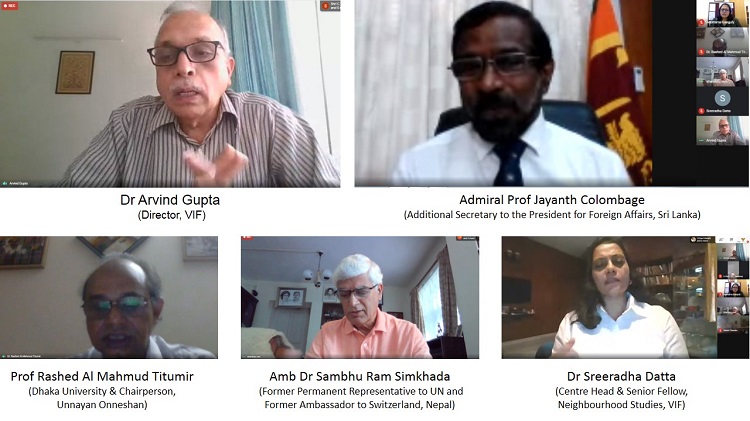
However, some of the cultural aspects of South Asia, like the way we greet and interact by folding our hands in namaskar, and not by hugging or shaking hands, the culture of washing hands and keeping shoes outside as well as eating patterns has probably given this region a certain advantage. There are also examples of efficient management in Sri Lanka to control the spread of the virus by undertaking measures such as the formation of Action Committee and implementation of an effective strategy: to test, trace, treat and quarantine.
Highlighting the economic challenges faced by the South Asian countries, the discussion compared the pre-COVID and post-COVID economic conditions in Bangladesh and Sri Lanka. It reflected on the structural rigidities of Bangladesh economy, due to excessive dependence on exports, and concentration in few sectors such as garments. Sri Lanka on the other hand, being an import-dependent country, has also suffered due to current crises. There are worries about the fall in tourism industry and air travels, reduced scales of shipping and serious disruptions of small-scale industries. The speakers also identified the plight of migrant workers and a 3Rs solution to address the economic problems was given; ‘Relief’, ‘Reassure people’ of State Responses and ‘Recreate employment’, especially in the agriculture sector.
The speakers expressed concerns about China’s irresponsibility to raise the warning about the growing virus in their country. And despite China being the largest trading partner, they stressed on the need for serious recalibration on China’s economic involvement in each of the States. Though China’s presence can’t be eliminated, at least the high dependence should be reduced.
The discussion appreciated the efforts undertaken by the Indian Government to call a meeting for SAARC nations and also evacuate Indians and the citizens of the neighbouring countries, from across the world. The speakers praised India’s ingenuity to proactively supply medical equipment to its neighbouring countries despite crises reeling at home. However, they also stressed that India should further take efforts and engage with the neighbours, as there are voices against India not doing enough. Nevertheless, it was also argued that India has acted in altruistic ways to provide net security in the region.
SAARC’s potential is unmatched has been reiterated in the course of discussion and it further expressed the need to integrate the region to emerge as “Atmanirbhar South Asia”. There is a need to enhance intra-region trade, which is currently around 5 per cent. The speakers suggested formation of shared networks of production and incremental regional value chains. The two key areas of cooperation for SAARC, i.e., food security and medicines were identified. There are concerns about the stalling of SAARC due to India-Pakistan bilateral issues, and it was recommended that we need to rework on the lines of sub-regional groupings as done by other organisations.
Dr Gupta made the concluding remarks by reiterating the need to work on a common strategy to be self-sufficient in food and medicines. He emphasised on the need to immediately start working and cooperating, instead of being hostage to any institutional framework. In the end, he remarked the need for South Asia to build it’s thinking on its culture and civilization, which has a long history of existence.

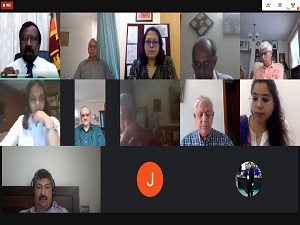
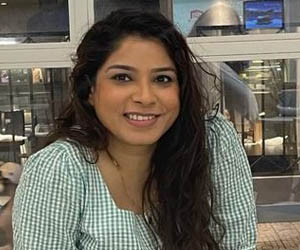
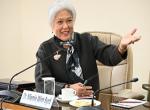





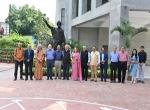
Post new comment